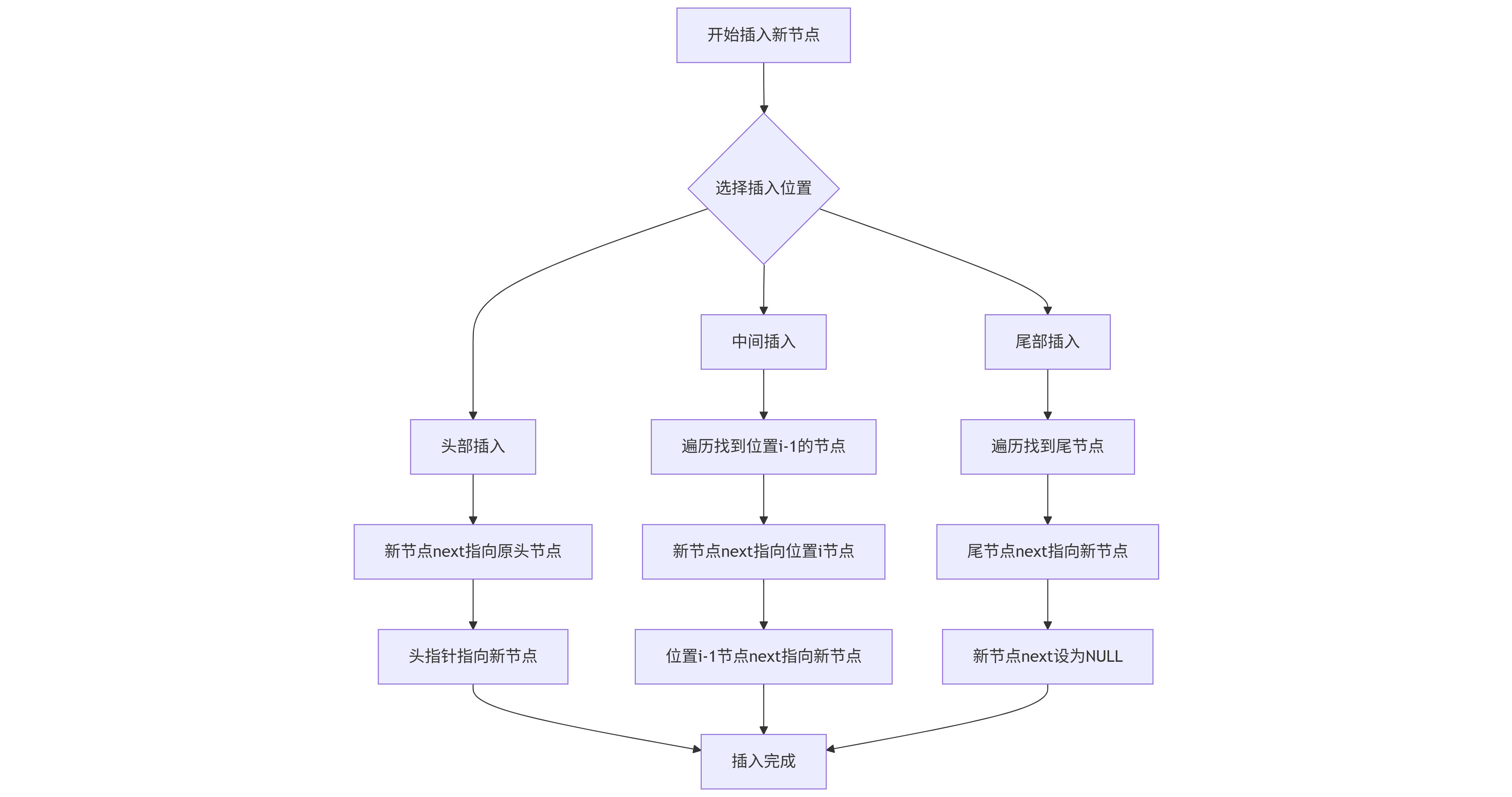cs
复制代码
#include <stdio.h>
#include <stdint.h>
#include <stdbool.h> // 为了使用 bool 类型
typedef struct ListNode {
int data; // 数据域,这里以int为例
struct ListNode* next; // 指针域,指向下一个节点
} ListNode, * LinkList;
/*
判断链表是否为空 (is_empty)
检查链表中是否存在数据节点
1.带头结点的链表 -- 第一个节点是头结点,不存储实际数据,其next指针指向第一个数据节点。
2.不带头结点的链表 -- 头指针直接指向第一个数据节点。
*/
// 判断链表是否为空(带头结点)
/*
带头结点的链表通常有一个不存储实际数据的头结点,其 next 指针指向第一个有效结点。
判断链表是否为空,只需检查头结点的 next 是否为 NULL。
若 head->next 为 NULL,说明链表没有有效结点,返回 true。
*/
bool IsEmpty(ListNode* head)
{
return head->next == NULL;
}
// 创建一个只有头结点的空链表
ListNode* initList() {
ListNode *head = (ListNode*) malloc(sizeof(ListNode));
if (head == NULL) {
printf("内存分配失败!\n");
exit(1); // 或者返回NULL,由调用者处理错误
}
head->next = NULL; // 头结点指针域初始化为NULL
return head;
}
// 头插法(在头结点后插入新节点)
void insertAtHead(ListNode *head, int value) {
ListNode *newNode = (ListNode*) malloc(sizeof(ListNode));
newNode->data = value;
newNode->next = head->next; // 新节点指向原首节点
head->next = newNode; // 头结点指向新节点
}
// 尾插法(在链表末尾插入新节点)
void insertAtTail(ListNode *head, int value) {
ListNode* current = head;
while (current->next != NULL) { // 找到最后一个节点
current = current->next;
}
ListNode *newNode = (ListNode*) malloc(sizeof(ListNode));
newNode->data = value;
newNode->next = NULL;
current->next = newNode;
}
// 指定位置插入
void insertAtIndex(ListNode *head, int index, int value) {
if (index < 0) return;
ListNode *current = head;
for (int i = 0; current != NULL && i < index; i++) {
current = current->next;
}
if (current == NULL) return; // 索引超出范围
ListNode *newNode = (ListNode*) malloc(sizeof(ListNode));
newNode->data = value;
newNode->next = current->next;
current->next = newNode;
}
// 删除操作,按值删除
void deleteByValue(ListNode *head, int value) {
ListNode *prev = head;
ListNode *current = head->next;
while (current != NULL) {
if (current->data == value) {
prev->next = current->next;
free(current);
return;
}
prev = current;
current = current->next;
}
printf("抱歉,此时链表中不存在value: %d \n",value);
}
// 按位置删除
void deleteByIndex(ListNode *head, int index) {
if (index < 0) return;
ListNode *prev = head;
ListNode *current = head->next;
for (int i = 0; current != NULL && i < index; i++) {
prev = current;
current = current->next;
}
if (current == NULL) return; // 索引超出范围
prev->next = current->next;
free(current);
}
// 查找操作,按值查找
ListNode* searchByValue(ListNode *head, int value) {
int count = 0;
ListNode *current = head->next;
while (current != NULL) {
if (current->data == value) {
printf("value:%d 当前位置为 %d \n",value, count);
return current;
}
current = current->next;
count++;
}
return NULL; // 未找到
}
// 按位置查找
ListNode* searchByIndex(ListNode *head, int index) {
if (index < 0) return NULL;
ListNode *current = head->next;
for (int i = 0; current != NULL && i < index; i++) {
current = current->next;
}
return current; // 可能返回NULL(索引超限)
}
// 遍历链表
void traverseList(ListNode *head) {
ListNode *current = head->next;
while (current != NULL) {
printf("%d ", current->data);
current = current->next;
}
printf("\n");
}
// 销毁链表
void destroyList(ListNode *head) {
ListNode *current = head;
while (current != NULL) {
ListNode *temp = current;
current = current->next;
free(temp);
}
}
int main()
{
printf("Hello, World!\n");
LinkList * head = initList();
insertAtHead(head,5);
insertAtHead(head,10);
insertAtTail(head,20);
traverseList(head);
ListNode* pos = searchByValue(head,20);
deleteByValue(head,20);
traverseList(head);
deleteByValue(head,20);
bool isEmpty = IsEmpty(head);
printf("此链表是否为空? %s",isEmpty ? "true" : "false");
return 0;
}
